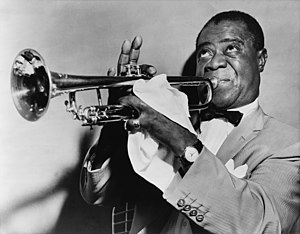|
When the Saints Go Marching In
 "When the Saints Go Marching In", um hino gospel estadunidense tão conhecido que muitas vezes é citado apenas como "The Saints", assumiu alguns aspectos de música folclórica. Embora sua origem seja religiosa, hoje em dia as pessoas se acostumaram a ouví-lo interpretado por bandas de jazz. LetraComo ocorre com muitas composições folclóricas em uso por muito tempo, não há uma versão "oficial" da canção ou de sua letra. A confusão se estende ao próprio título, o qual é frequente e erroneamente trocado por When the Saints Come Marching In, fazendo parecer que os santos citados estão indecisos quanto a ir ou vir. Quanto a própria letra, sua grande simplicidade a torna factível de gerar novas estrofes. Visto que a primeira, segunda e quarta linhas de cada estrofe são exatamente as mesmas, e a terceira é um padrão do início ao fim, a criação de uma linha conveniente em tetrâmetro iâmbico origina uma estrofe inteira. É quase impossível ouvir-se todas as versões da canção, mas a mais comum é esta:
Não é incomum que as primeiras duas palavras da terceira linha da estrofe em comum ("Lord, how") sejam ditas como "Oh, Lord" ou mesmo "Lord, Lord." Os arranjos variam consideravelmente. O mais simples é apenas uma repetição interminável do refrão. As estrofes podem se alternar com o refrão, ou inserir a terceira de quatro repetições para criar um formato AABA com a estrofe como ponte. Uma estrofe comum em versões "apimentadas" de Nova Orleans declara (com variações consideráveis):
Alguns arranjos tradicionais também contemplam corais em vez de vozes individuais. É também comum que a canção seja cantada por platéias. Ainda, versões usando "chamado e resposta" são freqüentemente ouvidas, como em:
Referências
Ligações externas
|
Portal di Ensiklopedia Dunia